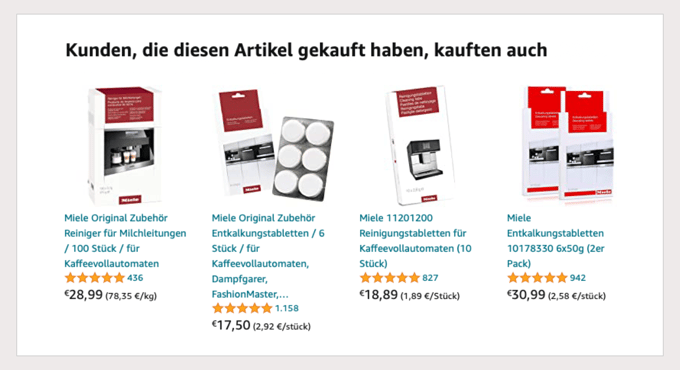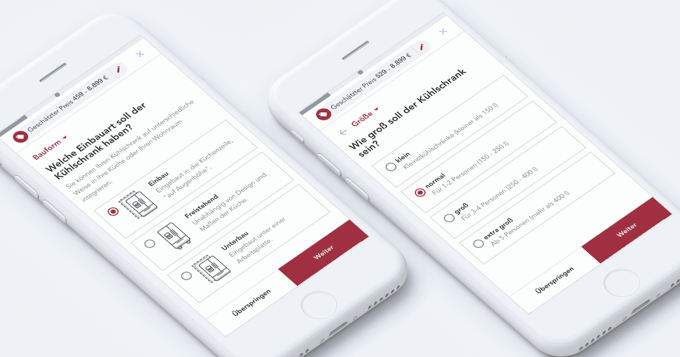The analysis of individual customer preferences on an online sales platform is enormously important, because understanding the customer journey determines whether the customer ultimately buys or not. Recommender systems (recommendation systems) in e-commerce help to recognise the behaviour of customers at an early stage and thus respond to their wishes in a personalised manner. Referral services provide well-founded data on the buying behaviour of potential buyers and thus influence the buying decision
In the growing jungle of online shops, it can be a real challenge to stand out from the competition. Recommendation services based on artificial intelligence play an important role in responding to customers' needs and suggesting the right products! What a trained salesperson takes over in the retail store, who almost reads the customer's wishes from his lips, replaces the Recommendation Engine online.
Amazon has been offering this form of cross-selling marketing for years. If you buy a book, you will see suggestions on what other customers have also bought further down the page. Clothing shops such as Zalando, Otto or e-bike retailers such as fahrrad.de also respond to customer needs with suitable product suggestions.
Who does not know them: the magic ideas suitable to the selection, if the shopping cart is already full: "Other customers have also bought these books" or "This accessory you might also like", and "Look at similar articles to your search"!

While you browse through the product selection and click here, sometimes there, the Online Recommendation Engine runs in the background, which immediately analyzes your buying behaviour and creates a profile of your preferences and needs
What are Recommender Systems?
Recommender systems can be divided into five different system models, depending on how they respond to customer behavior. The recommendation services strengthen cross & up-selling marketing in particular. If a product is in the shopping cart, a suitable item is recommended before purchase. Or the customer receives an email with personalized ideas for the next visit after their purchase.
The algorithm of the product recommendation software evaluates each search and each purchase decision in order to better respond to the prospective customer. Through personalized product recommendations, a company can influence the customer to make a faster purchase decision. The more positive experiences the prospective customer experiences in a webshop through suitable product suggestions, the more they feel connected to the company and remain loyal to the brand.
Recurring systems can be divided into five models*:
1) Collaborative Filtering System: analyzes a user's behavior to infer their preferences
2) Demographics-based filtering system: customer data is analyzed by categories, such as age, gender or place of residence
3) Content-based filtering system: product recommendations based on similarity to the content or products you are looking for
4) Knowledge-based recommendation system: evaluation of the shopping cart or the purchasing behaviour from previous purchases in order to respond to individual preferences
5) Hybrid system: an overlap of all previously mentioned models
* Leitfaden Customer Experience, Stefan Schulte & Thorsten Schwarz
Advantages of the Recommender Systems
Recommender systems are particularly important before and after the purchase decision. Before buying, if the goods are still in the shopping cart, e-commerce recommendations offer perfect cross-selling possibilities. The hiking shoes are in the shopping cart, why not buy the matching windproof jacket?
After the purchase, Recommender Systems offer the opportunity to create personalized emails based on data science and to tailor them to the needs of the customer. This leads to a higher email opening rate and, at best, to a higher click-through rate and further sales.
The advantages on a glance:
👉 Analysis of customers' buying behaviour by the software
👉 Up-selling opportunities through accurate customer knowledge
👉 Cross-selling options through recommendations suitable for product search
Disadvantages of the reccuring systems
Product recommendations make sense, if the customer has already found what he is looking for. In line with this, further articles are suggested to him through Recommendation Engines, which encourage him to make another purchase. For the bike lover, for example, this is an extra light, for the fashion fan a new sunglasses or for the bookworm another book.
What Recommendation Engine providers can not do, is to lead the customer faster to a desired product or to shorten the customer journey if the customer is overwhelmed by 30,000+ products.
In this case a Guided Selling software is the right one. This picks up the customer directly at the first contact with the website, and guides through targeted questions to the perfect article, as a consultant would do in the retail store. This increases the customer's loyalty to the company and avoids early cancellations.
Guided selling as a perfect complement to Recommender Systems
Guided sales advice in e-commerce optimizes the purchase process and leads to a faster purchase decision. Inappropriate products are not seen in the first place and the customer's choice becomes more specific with every question. Alternatives, the best price-performance ratio or the product with the best quality can also be filtered out. Click here for the Guided Selling definition.
The Guided Selling software starts where Recommender Systems do not yet work: when searching for the perfect product! Because what is the use of additional product suggestions if the customer has not yet found what he is visiting the online shop for?
Guided Selling guides the customer through an online platform with a guide based on playbooks to separate the chaff from the wheat. This saves time and prevents unnecessary distractions due to an excess of products, which often leads to frustration and a cancellation of purchase.
"Should it be a built-in refrigerator or a free-standing refrigerator?", "Detached. Okay, is this for a single or for a family?", "Family. Okay, should the fridge have an extra vegetable drawer?", "Ok. Best quality or best value for money?" and so on.
The digital buying advisor is at the customer's side from start to finish and significantly influences the purchasing decision. The customer journey is thus much more pleasant, the customer does not lose endless time browsing for the right product and can narrow down his search more and more. The quicker the customer finds what they are looking for, the easier it is to click on "Buy now".

Conclusion: Recommender Systems and Guided Selling
Where limited search fields from online providers lead to an excess of suggestions, such as 'black or white‘, ‘T-shirt or sweater ‘,‘summer or autumn‘, Guided Selling can provide accurate data. The cornerstones, determined by artificial intelligence and data science about the customer's purchasing behaviour, make it possible to accommodate the prospective customer and propose the right product in a targeted manner, instead of distracting or overwhelming him.
After Guided Selling has skilfully responded to customer requests and helped the customer to make a quick purchase decision, recommender systems come into play. After the satisfied customer has found what he is looking for, it is much easier to encourage him to buy more items that match his search.
Guided Selling and Recommender Systems (in order) = Match made in heaven.
Both systems have their justification and help to make the customer's buying experience more pleasant. After all, who wants to spend hours in an online shop looking for a needle in a haystack? The more personal, individual and faster the purchase process for the customer, the sooner he returns and remains loyal to the brand.
We hope the article about recommender systems in e-commerce has inspired you! Download our case study with Paulmann Licht to find out about their success with Guided Selling or book a demo with us directly!